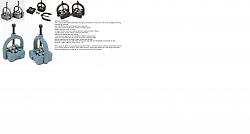Bear with me on this one; it's going to take a bit of background to get to the point.
When I was first starting out I decided that, if I intended to use tools, I should know how they look and what they do. My approach, which I heartily recommend to all neophytes, was to go through the MSC catalogue page by page. If I saw a tool whose purpose or use was unknown to me, I would investigate until I understood it even if it was something I'd never own or use. What I learned by this exercise has been of immense aid to me ever since. Understand, this was all done in the days before the internet so it was time consuming and often tedious. However, if you don't have the patience to apply yourself you'll have real trouble developing skills; plus, today, with the internet, it's ever so much easier to discover what things are and how they work.
Too many people, encountering a new object or mechanism whose purpose they don't understand will blow it off with "Who knows?" and rejoice in the fact that they've yet again avoided learning something. Need I say that that is a bad attitude in wood and metal working and an even worse attitude in life?
OK, back to the subject... One of the new-to-me things I encountered while doing this was a Starrett precision level with an involute base. I puzzled over that base for quite a while before I understood why that was desirable. I tucked that bit of learning away and went on. The level was so bloody expensive that I'd probably never own one (I do own a less expensive version now) and, even if I did, wouldn't need the involute feature.
So, one day rooting around in my favorite supplier of aircraft aluminum offcuts, I stumble upon a piece that has a profile like this...
I flashback to my early catalogue-reading days and say, "Why there's an involute V-block lurking in that." Scarfed it up and, as the picture shows cut it into several pieces to use in the milling vise.
Now, to be fair, it's not a true mathematical involute as used in designing gear teeth, but it's very similar and I need a single word description to keep this already lengthy post shorter, so I'll continue to refer to it that way.
Why do we need or want involute V-blocks? An ordinary, straight-sided V-block isn't much good for locating parts with a diameter greater than the width of the mouth of the 'V', as this picture demonstrates...
Any side pressure on the bronze bushing will easily dislodge it from the V-groove.
But an involute can provide reasonable support for a much larger range of diameters.
The central slot is 0.5" wide so this involute V-block can handle material from slightly larger than 0.5" up to the 1.5"+ diameter of the bronze bushing in a block that is only 0.5" thick.
Let's look at a practical application. In a previous thread...
http://www.homemadetools.net/forum/p...5615#post82203
I described a prismatic 'V' jaw I made for the Panavise. As is obvious from this picture...
using it to secure a large diameter part is a non-starter. So I made an involute jaw and it accommodates the part handily...
The involute jaw has two strips of wood glued onto the back to locate it on the existing Panavise jaw. Also glued there are two supermagnets obtained from Harbor Freight...
Rare Earth Magnets - Rare Earth Magnet Set, 10 Piece
which keep the jaw in place.
I was lucky to find my involute form stock but you can easily make your own. Woodworking tools work well in aluminum. After milling out the central slot between the two involute walls, use a router round-over bit to form the quarter circle walls. I'm not a woodworker but I'm guessing that, for a woodworker version, one could glue strips of quarter round to a baseboard of some sort.
Even if you don't build one, keep the concept in mind; you may need it some day.



 LinkBack URL
LinkBack URL About LinkBacks
About LinkBacks








 Reply With Quote
Reply With Quote




Bookmarks